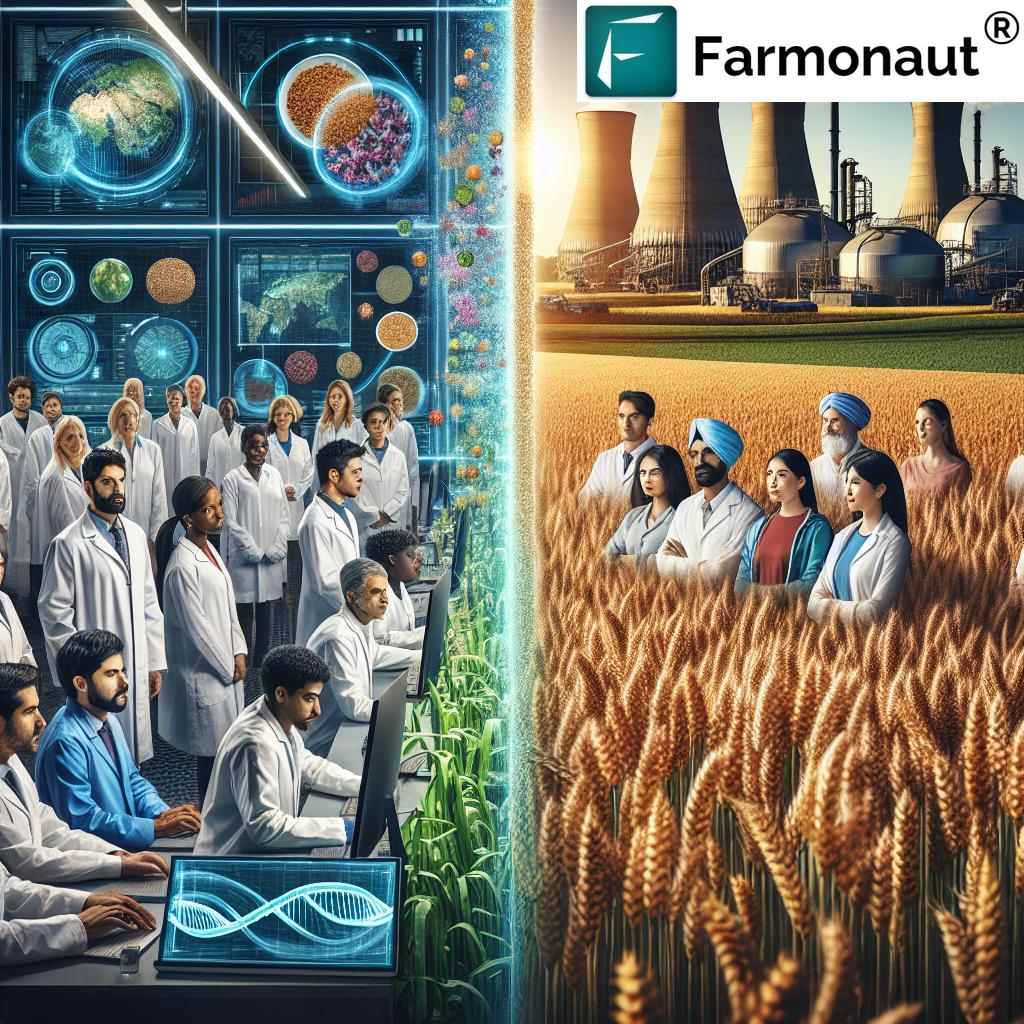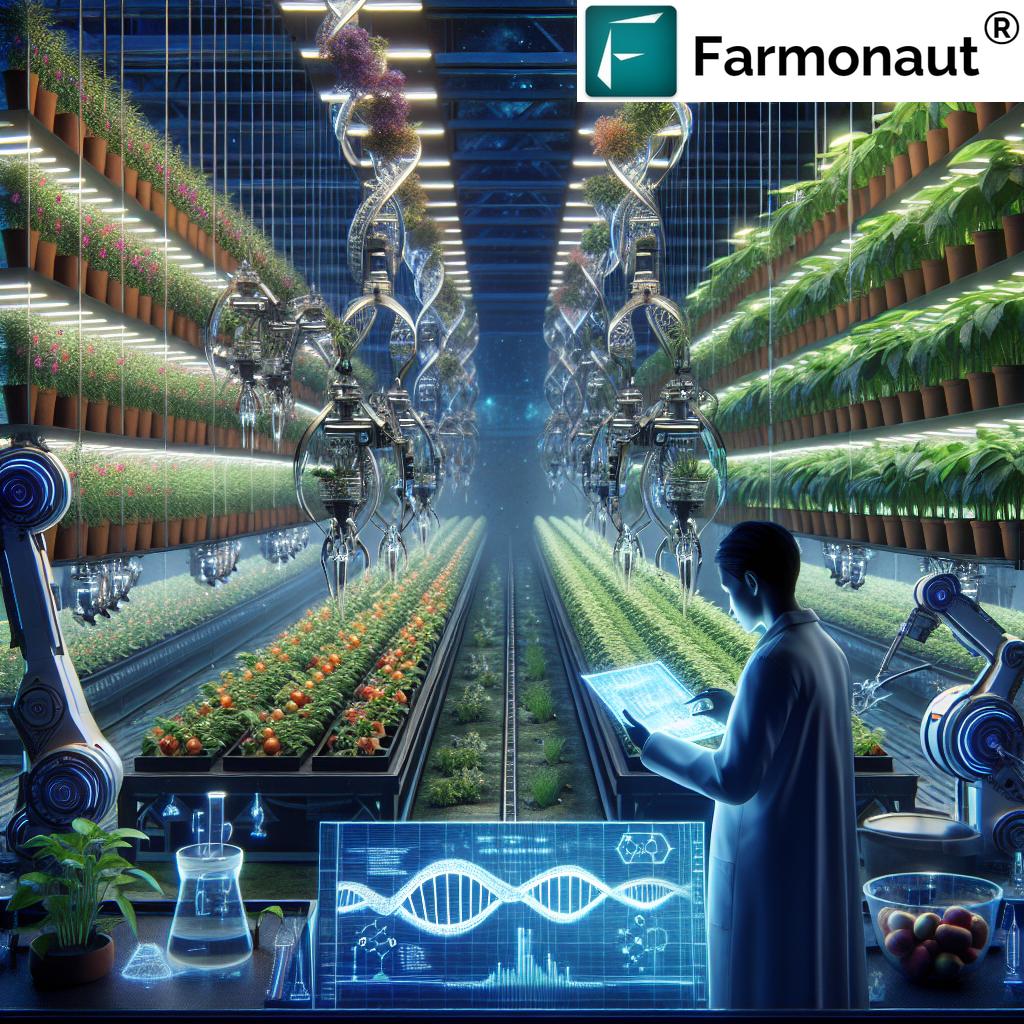Revolutionizing Agriculture: How CRISPR and Gene Editing Are Shaping the Future of Sustainable Farming in Canada
“CRISPR gene editing can potentially increase crop yields by up to 50% while reducing pesticide use by 37%, according to recent studies.”
In the ever-evolving landscape of agriculture, we stand at the cusp of a revolutionary transformation. The integration of CRISPR technology and gene editing into agricultural practices is reshaping the future of farming, particularly in Canada. As we delve into this exciting realm of agricultural biotechnology, we’ll explore how these cutting-edge innovations are addressing global food security challenges while promoting sustainable farming methods.
Understanding CRISPR and Gene Editing in Agriculture
CRISPR, which stands for Clustered Regularly Interspaced Short Palindromic Repeats, has emerged as a game-changing tool in genetic editing. This precise gene-editing technique allows scientists to make targeted modifications to DNA sequences, offering unprecedented opportunities for crop improvement and disease resistance.
In the context of agriculture, CRISPR technology applications are vast and promising. From developing disease-resistant plants to enhancing crop yield improvement, the potential of gene-edited crops is transforming the agricultural landscape. Let’s explore some key areas where CRISPR is making significant strides:
- Disease Resistance: By editing specific genes, scientists can create crops that are naturally resistant to various diseases, reducing the need for pesticides and improving overall crop health.
- Drought Tolerance: Gene editing can enhance plants’ ability to withstand water scarcity, a crucial trait in the face of climate change.
- Nutritional Enhancement: CRISPR allows for the modification of crops to increase their nutritional value, addressing global malnutrition challenges.
- Yield Improvement: Through targeted genetic modifications, crops can be engineered to produce higher yields, contributing to food security.
The Canadian Landscape of Agricultural Biotechnology
Canada has been at the forefront of embracing agricultural biotechnology, recognizing its potential to address various challenges in the farming sector. The country’s commitment to innovation in this field is evident in its substantial investments and progressive regulatory framework.
“Canada has invested over $400 million in agricultural biotechnology research since 2015, with 30% focused on CRISPR applications.”
This significant investment underscores Canada’s dedication to leveraging genetic editing technologies for sustainable agriculture. Let’s examine how CRISPR and gene editing are specifically shaping Canadian agriculture:
- Canola Improvement: As a major canola producer, Canada is utilizing CRISPR to develop canola varieties with enhanced oil profiles and increased resistance to clubroot disease.
- Wheat Research: Scientists are working on creating wheat varieties with improved drought tolerance and increased protein content using gene editing techniques.
- Fruit Crop Enhancements: CRISPR is being employed to develop apple varieties resistant to fire blight and to improve the shelf life of berries.
The integration of these technologies is not just about crop improvement; it’s about creating a more sustainable and resilient agricultural system. As we continue to face challenges like climate change and population growth, the role of genetic editing in agriculture becomes increasingly crucial.

Precision Agriculture Innovations: Beyond Gene Editing
While CRISPR and gene editing are revolutionizing crop development, they’re not the only technological advancements shaping modern agriculture. Precision agriculture innovations are complementing these genetic techniques, creating a holistic approach to farm management. Here’s where companies like Farmonaut come into play, offering cutting-edge solutions that work in tandem with genetic advancements.
Farmonaut’s satellite-based farm management solutions provide farmers with real-time insights into crop health, soil moisture levels, and other critical metrics. This data-driven approach allows farmers to make informed decisions about irrigation, fertilizer usage, and pest management, optimizing crop yields and reducing resource wastage.
Key features of Farmonaut’s technology include:
- Satellite-Based Crop Health Monitoring: Using multispectral satellite images to assess vegetation health (NDVI) and soil moisture levels.
- AI-Driven Advisory Systems: Providing personalized farm advice based on real-time data analysis.
- Blockchain-Based Traceability: Ensuring transparency and security in agricultural supply chains.
- Resource Management Tools: Optimizing the use of water, fertilizers, and other inputs.
These precision agriculture tools, when combined with genetically improved crops, create a powerful synergy that can significantly enhance farm productivity and sustainability.
The Ethical Considerations of Agricultural Biotechnology
As we embrace the potential of CRISPR and gene editing in agriculture, it’s crucial to address the ethical considerations surrounding these technologies. The debate on genetic engineering ethics in agriculture is multifaceted, involving concerns about biodiversity, environmental impact, and consumer rights.
Key ethical considerations include:
- Biodiversity Preservation: Ensuring that gene-edited crops don’t negatively impact local ecosystems and biodiversity.
- Consumer Choice and Labeling: Providing transparent information about genetically modified organisms (GMOs) and gene-edited products.
- Intellectual Property Rights: Balancing innovation protection with equitable access to technology for farmers.
- Environmental Safety: Assessing the long-term environmental impacts of gene-edited crops.
Canada has been proactive in addressing these concerns through its regulatory framework. The country’s approach to regulating gene-edited crops focuses on the product rather than the process, allowing for a more nuanced evaluation of each new crop variety.
Comparative Analysis of CRISPR Applications in Canadian Agriculture
| Crop Type | CRISPR Application | Potential Benefits | Estimated Yield Improvement | Regulatory Status | Environmental Impact |
|---|---|---|---|---|---|
| Wheat | Drought Tolerance | Increased resilience to water scarcity | 15-20% | Under Review | Medium |
| Canola | Disease Resistance (Clubroot) | Reduced need for pesticides | 25-30% | Approved | Low |
| Soybeans | Enhanced Protein Content | Improved nutritional value | 10-15% | Research Phase | Low |
| Apples | Fire Blight Resistance | Reduced crop losses | 20-25% | Under Review | Low |
| Potatoes | Late Blight Resistance | Reduced fungicide use | 30-35% | Approved | Medium |
This table provides a clear overview of how CRISPR technology is being applied to various crops in Canada, highlighting the potential benefits and current regulatory status of each application. It’s important to note that these figures are estimates based on current research and may evolve as the technology progresses.
The Role of Artificial Intelligence and IoT in Modern Agriculture
The integration of artificial intelligence (AI) and the Internet of Things (IoT) is further amplifying the impact of genetic editing in agriculture. These technologies are creating smart farming systems that can optimize the performance of gene-edited crops in real-world conditions.
AI and IoT applications in agriculture include:
- Predictive Analytics: AI algorithms can predict crop yields, disease outbreaks, and optimal harvest times.
- Automated Irrigation Systems: IoT sensors coupled with AI can optimize water usage based on real-time soil and weather conditions.
- Robotic Farming: Autonomous machines can perform tasks like planting, weeding, and harvesting with precision.
- Pest Management: AI-powered systems can detect and manage pest infestations more efficiently.
Farmonaut’s platform integrates these technologies, offering farmers a comprehensive solution that combines satellite imagery, AI-driven insights, and precision agriculture tools. This synergy between genetic improvements and smart farming technologies is paving the way for a more efficient and sustainable agricultural future.
Explore Farmonaut’s API for advanced agricultural insights

Global Perspectives on Gene-Edited Crops
While Canada has been progressive in its approach to gene-edited crops, the global landscape is diverse. Different countries have varying regulatory frameworks and public perceptions regarding these technologies. Let’s examine how some key regions are approaching gene-edited crops:
- United States: The U.S. has a generally favorable stance towards gene-edited crops, with a regulatory framework that focuses on the end product rather than the process.
- European Union: The EU has stricter regulations, treating gene-edited crops similarly to GMOs, requiring extensive testing and labeling.
- China: China is investing heavily in gene editing research but maintains strict regulations on GM crop cultivation.
- Australia: Recently updated regulations to exclude some gene editing techniques from GM regulations, aligning more closely with Canada and the U.S.
These diverse approaches highlight the complex global landscape of agricultural biotechnology. As international trade in agricultural products continues to grow, harmonizing these regulatory frameworks becomes increasingly important.
The Future of Sustainable Farming: Integrating Multiple Technologies
As we look to the future of sustainable farming in Canada and beyond, it’s clear that no single technology will provide all the answers. Instead, the path forward lies in the intelligent integration of multiple advanced technologies, including:
- CRISPR and Gene Editing: Continuing to develop crops with enhanced traits for resilience and productivity.
- Precision Agriculture: Utilizing data-driven approaches to optimize resource use and crop management.
- Artificial Intelligence: Leveraging AI for predictive analytics and automated decision-making in farming.
- Robotics: Implementing autonomous systems for various farming tasks to increase efficiency and reduce labor costs.
- Blockchain: Ensuring transparency and traceability in the agricultural supply chain.
Companies like Farmonaut are at the forefront of this integration, offering platforms that combine satellite imagery, AI, and precision agriculture tools. These comprehensive solutions enable farmers to make data-driven decisions that complement the benefits of gene-edited crops.
Access Farmonaut’s API Developer Docs for advanced integration
The Role of Education and Public Engagement
As we continue to advance in agricultural biotechnology, public education and engagement become crucial. Addressing misconceptions about gene editing and GMOs is essential for gaining public trust and support for these technologies. Key aspects of this educational effort include:
- Transparent Communication: Clearly explaining the science behind gene editing and its potential benefits.
- Addressing Concerns: Openly discussing and addressing public concerns about safety and environmental impact.
- Highlighting Success Stories: Showcasing real-world examples of how gene-edited crops have improved farming practices and food security.
- Engaging Stakeholders: Involving farmers, consumers, and policymakers in discussions about the future of agriculture.
By fostering an open dialogue and providing accurate information, we can build a more informed and supportive public opinion on agricultural biotechnology.
Conclusion: A New Era of Sustainable Agriculture
As we’ve explored throughout this article, the integration of CRISPR technology, gene editing, and precision agriculture tools is ushering in a new era of sustainable farming in Canada and around the world. These advancements offer promising solutions to some of the most pressing challenges in agriculture, from climate change resilience to improved food security.
While there are still challenges to overcome, including regulatory hurdles and public perception, the potential benefits of these technologies are immense. By continuing to invest in research, fostering innovation, and promoting open dialogue, we can work towards a future where agriculture is not only more productive but also more sustainable and environmentally friendly.
As we move forward, it’s crucial to approach these advancements with a balanced perspective, considering both the potential benefits and the ethical implications. With thoughtful implementation and ongoing research, gene editing and precision agriculture technologies have the power to revolutionize farming practices, ensuring a more food-secure future for generations to come.
FAQs
- What is CRISPR technology, and how is it used in agriculture?
CRISPR is a precise gene-editing tool that allows scientists to make targeted modifications to DNA sequences. In agriculture, it’s used to develop crops with enhanced traits such as disease resistance, drought tolerance, and improved nutritional content. - How does gene editing differ from traditional GMOs?
Gene editing makes precise changes to an organism’s existing DNA, while traditional GMOs often involve introducing DNA from other species. Gene editing is generally considered more precise and can achieve similar results to traditional breeding methods, but much faster. - Is food from gene-edited crops safe to eat?
Current scientific consensus suggests that gene-edited crops are as safe as conventionally bred crops. However, each new variety undergoes rigorous safety assessments before approval for human consumption. - How is Canada regulating gene-edited crops?
Canada regulates gene-edited crops based on the novel traits of the final product, rather than the process used to create them. This approach allows for a case-by-case assessment of new crop varieties. - Can gene editing help in combating climate change?
Yes, gene editing can develop crops that are more resilient to climate change effects such as drought, extreme temperatures, and changing pest patterns. This can help maintain food security in the face of changing environmental conditions.






